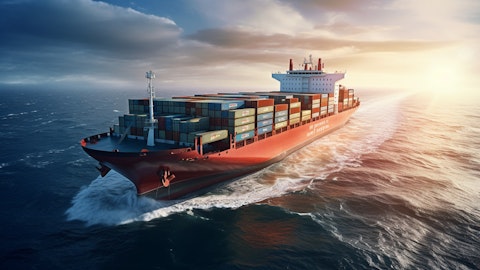Par Pacific Holdings, Inc. (NYSE:PARR) Q3 2025 Earnings Call Transcript November 5, 2025
Operator: Good morning, and welcome to the Par Pacific Third Quarter Earnings Call. [Operator Instructions] I would now like to turn the conference over to Ashimi Patel, Vice President of Investor Relations. Please go ahead.
Ashimi Patel: Thank you, George. Welcome to Par Pacific’s Third Quarter Earnings Conference Call. Joining me today are William Monteleone, President and Chief Executive Officer; Richard Creamer, EVP of Refining and Logistics; and Shawn Flores, SVP and Chief Financial Officer. Before we begin, note that our comments today may include forward-looking statements. Any forward-looking statements are subject to change and are not guarantees of future performance or events. They are subject to risks and uncertainties, and actual results may differ materially from these forward-looking statements. Accordingly, investors should not place undue reliance on forward-looking statements, and we disclaim any obligation to update or revise them. I refer you to our investor presentation on our website and to our filings with the SEC for non-GAAP reconciliations and additional information. I’ll now turn the call over to our President and Chief Executive Officer, William Monteleone.
William Monteleone: Thank you, Ashimi, and good morning, everyone. We are pleased to announce strong third quarter operating and financial results. The organization fired on all cylinders as we safely and reliably throughput a near record 198,000 barrels per day, maximized logistics system utilization and delivered above industry trend retail results. This crisp commercial and operational execution drove core financial results of $170 million and $2.10 in adjusted EBITDA and adjusted EPS, respectively. In addition, we captured the benefit of small refinery exemptions, resulting in an earnings boost of approximately $200 million. In total, third quarter adjusted EBITDA was $372 million and adjusted net income was $5.95 per share.
As we enter November, we are optimistic about the market outlook. Product margins are rallying in response to tight fundamental supply and demand balances and heightened geopolitical disruptions. Our fourth quarter combined index averaged $15.55 per barrel in October, up from the third quarter. While we typically expect fourth quarter seasonal market conditions to taper off due to lower gasoline margins, our distillate production orientation is lifting our combined index. The Retail business continues to deliver exceptional results, reflecting encouraging trends from improved focus on inside sales and gross margin. In particular, we’re seeing improving food top and bottom line results. Quarterly same-store fuel and in-store revenue increased by 1.8% and 0.9% compared to the third quarter of 2024.
Looking forward, our development pipeline is expanding with the recent groundbreaking on our second new-to-industry store in the Pacific Northwest and an expanding list of attractive redevelopment or new-to-industry opportunities in Hawaii. We’ve made considerable progress on our key strategic objectives this year. In Montana, we’re pleased with a strong third quarter result, reflected both by record quarterly throughput and OpEx per barrel under our ownership. As throughput increases, we’re quickly debottlenecking new constraints. Like our other acquisitions, we have developed an attractive list of low-capital, high-return projects that will allow us to increase the mid-cycle earnings power of the Billings asset from our original expectations.
These projects focus on improved logistics flexibility and efficiency, lighter crude processing, expanded hydrotreating capacity and enhanced jet and diesel production capabilities. The Hawaii SAF project continues to progress towards startup. We’ve achieved mechanical completion and startup of the pretreatment unit and are encouraged by the early results. Focus has turned towards completing construction of the remaining reactors and associated systems. We are targeting mechanical completion by the late fourth quarter and startup shortly thereafter. We are also pleased to announce the closing of the Hawaii Renewables joint venture with Mitsubishi and ENEOS in late October. We’ve received $100 million in proceeds and are excited by the prospects of this newly formed partnership.
Our balance sheet continues to strengthen, and we expect further improvement as we convert this quarter’s strong earnings to cash and record the inflow associated with the Hawaii SAF joint venture. The combination of our strong financial position and solid operating momentum positions us to pursue growth and continue opportunistic share repurchases. I’ll now turn the call over to Richard to discuss Refining and Logistics operations.
Richard Creamer: Thank you, Will. Third quarter combined throughput was a strong 198,000 barrels per day, reflecting exceptional performance across all of our locations. We also achieved a new record low in Refining production costs at $6.13 per barrel. In Hawaii, throughput was 82,000 barrels per day. In September, the team set a new monthly throughput record of nearly 90,000 barrels per day, partially offsetting crude delivery delays that occurred in July. Production costs were $4.66 per barrel. Washington throughput was 39,000 barrels per day and production costs were $4.31 per barrel. Washington continues to excel in reliability and efficiency, capturing the benefits of a strong market environment. Shifting to Wyoming, throughput was 19,000 barrels per day and production costs were $8.11 per barrel.

The strong operating results and return to normalized production costs are reflective of the Wyoming team’s execution and resilience to operational challenges earlier this year. Finally, in Montana, third quarter throughput was a record high 58,000 barrels per day and production costs were a record low at $8.76 per barrel. This quarter’s performance is an example of the Billings refinery potential. Effective reliability investment and the team’s strong execution is yielding operational and cultural benefits that are consistent with our acquisition objectives. In the fourth quarter, we do anticipate lower throughput and increased costs associated with routine [ coker ] maintenance. Looking further into the fourth quarter, we expect system-wide throughput between 184,000 and 193,000 barrels per day.
Hawaii throughput is expected between 84,000 and 87,000 barrels per day and Washington between 35,000 and 37,000. Wyoming is forecasted to be between 15,000 and 16,000 barrels per day and Montana between 50,000 and 53,000. Both are reflective of seasonal market demand conditions. And Washington’s lower Q4 throughput guidance reflects crude unit inefficiencies that will be addressed during the Q1 2026 planned outage. I’ll now turn the call over to Shawn to cover our financial results.
Shawn Flores: Thank you, Richard. Third quarter adjusted EBITDA and adjusted earnings were $372 million and $303 million or $5.95 per share. The Refining segment generated adjusted EBITDA of $338 million compared to $108 million in the second quarter. Third quarter results include a $203 million gain associated with the full and partial small refinery exemptions granted for the 2019 through 2024 compliance periods. This gain reflects the expected cash benefit based on September 30 RIN prices and is included in our adjusted results since the related obligations were expensed in prior periods. For comparability, our regional commentary on margin capture will exclude the impact of the SRE benefits. Starting with Hawaii, the Singapore 3-1-2 averaged $16.34 per barrel and our crude diff was $6.07, resulting in a Hawaii Index of $10.27 per barrel.
Hawaii margin capture was 111%, including a combined $11 million impact from product crack hedging and price lag. Excluding these items, capture was 125%, reflecting lower purchase product costs and steady clean product freight rates. In Montana and Wyoming, margin capture was 93% and 91%, respectively, consistent with our target range and reflecting a return to normal operations following the second quarter turnaround and maintenance activity. Lastly, in Washington, our index averaged $16.66 per barrel, margin capture was 69%, reflecting the widening discount of jet relative to diesel during the third quarter. Looking to the fourth quarter, our combined Refining index averaged $15.55 per barrel in October, up nearly $1 per barrel compared to the third quarter, primarily driven by strength in the Singapore market.
The Singapore 3-1-2 Index averaged $20.52 per barrel in October, an increase of over $4 per barrel compared to the third quarter average. We expect our fourth quarter Hawaii crude differential to land between $5.50 and $6 per barrel. In the Rockies and the Pacific Northwest, distillate margins remained strong, partially offset by seasonal declines in gasoline and asphalt netbacks. Unplanned outages on the West Coast have narrowed jet to diesel spreads in October with prompt jet now trading at typical spreads to diesel in the Pacific Northwest. Moving to the Logistics segment, third quarter adjusted EBITDA was a record $37 million, up $7 million from the second quarter. The improvement reflects the return to normal summer operations in Montana and Wyoming and higher system utilization in Hawaii.
In our Retail segment, third quarter adjusted EBITDA was $22 million compared to $23 million in the second quarter. Retail results continue to outperform our mid-cycle target, supported by strong in-store sales growth, improved cost control and solid fuel margins. This marks the third consecutive quarter of record LTM retail adjusted EBITDA, which now stands at $86 million. Turning to cash flow, cash provided by operations was $219 million, including a working capital outflow of $147 million, primarily driven by higher RIN inventory associated with the small refinery exemptions. We expect the working capital impact to reverse over the next few quarters as we monetize our excess RIN position. Additionally, our federal tax assets continue to enhance the cash conversion of our earnings.
We began the year with an NOL balance of approximately $1 billion and have utilized over $375 million year-to-date, reducing our cash tax payments by $80 million. Cash used in investing activities totaled $32 million in the third quarter. Year-to-date, accrued CapEx and deferred turnaround expenditures totaled $204 million with our full year outlook trending toward the upper end of our $240 million guidance. Cash used in financing activities totaled $197 million, driven by an ABL paydown of $147 million and share repurchases of 16 million. Year-to-date, we’ve repurchased 5.7 million shares, reducing our basic share count by over 9%. Shifting to the balance sheet, gross term debt as of September 30 was $642 million or 3x our LTM Retail and Logistics EBITDA, positioning us at the low end of our 3 to 4x leverage target.
Quarter end liquidity increased 14% to $735 million, reflecting an excess capital position relative to our minimum liquidity of $300 million to $400 million. Looking ahead, cash proceeds from the Hawaii Renewables JV and future monetization of excess RINS are expected to further bolster our liquidity position. With a strong balance sheet and constructive outlook, we’re well positioned to pursue strategic growth and continue opportunistic share repurchases. This concludes our prepared remarks. George, we’ll turn it back to you for Q&A.
Q&A Session
Follow Par Pacific Holdings Inc. (NYSE:PARR)
Follow Par Pacific Holdings Inc. (NYSE:PARR)
Receive real-time insider trading and news alerts
Operator: [Operator Instructions] Our first question comes from Matthew Blair with Tudor, Pickering, Holt.
Matthew Blair: Congrats on the strong results overall. I would say that Washington capture might have been a little bit lower than our expectations. Was that primarily due to the dynamics on jet versus diesel in the quarter? And if so, would you expect that to reverse out in the fourth quarter?
Shawn Flores: Matt, it’s Shawn. That’s correct. We sell a fair amount of jet fuel out of our Tacoma facility. Our index really reflects the diesel market dynamics. And we saw, at least in the Pacific Northwest, jet to diesel spreads north of $20 per barrel. And as I mentioned in my prepared remarks, this spread is now compressed down to more typical levels. I think this morning, it’s trading $4 to $5 per barrel discount to diesel. So we estimated that was about a 15% capture impact to Q3. I think adjusting for that, we’re right sort of within our range of 85% to 95%.
Matthew Blair: Sounds good. And then could you also discuss the turnaround schedule for 2026? I think you might have mentioned some upcoming work at Washington. Are you also expecting any work at Hawaii or Wyoming? And what — any further comments on the timing and total capital cost of this planned activity next year?
William Monteleone: Matthew, it’s Will. I think consistent with our prior disclosures, we’re planning to conduct a turnaround in Hawaii next year. And we’re going to have a small planned outage in Washington, as Richard referenced, to address some of the crude unit inefficiencies that we’re seeing. And then we have elected to defer the Wyoming turnaround, given the time we had inside the units during the outage earlier this year. So that’s the main update on that front, and we’ll be back in front of everybody in December with our expectations on capital requirements.
Operator: Our next question comes from Ryan Todd with Piper Sandler.
Ryan Todd: Maybe one first on cash. You should see a significant influx in cash over the next few quarters in the form of JV — the payment from the JV and the reversal of the 3Q working capital headwind as you monetize the RINS from the SREs. And that’s on top of the organic free cash flow that you’re generating. During the third quarter, you were more active strengthening the balance sheet compared to share buybacks. How should we think about your priorities for the use of all this cash going forward?
William Monteleone: Sure, Ryan. It’s Will. You’re correct. I mean I think our balance sheet is improving quickly and is in good a shape as I’ve seen it. And again, I think that really positions us to both pursue growth as well as consider and weigh that against our share repurchase opportunity. And so I’d say over the near term, we’re focused on completing the construction on Hawaii Renewables project. And then as we kind of look into the future, we’re looking at projects that can propel the Montana business mid-cycle EBITDA generation higher. I’d say we see a mix of low capital and high-return implant projects as well as some enhanced logistics capabilities and market access opportunities that we see as most attractive in that area. And I would say, as always, we’ll weigh that against the opportunity to repurchase shares. And I think given our capital position, we can really do all of the above.
Ryan Todd: Great. And then maybe just a follow-up to some of your comments earlier. I mean you’re seeing quite a bit of strength in the Singapore margin environment. Can you maybe talk about what you’re seeing there in terms of drivers, sustainability of that strength? And how you think about the sustainability outlook there at the Hawaii refinery?
William Monteleone: Sure. You’re correct, Ryan. I think we’re seeing the Singapore margin environment at levels that would be almost consistent with, call it, the third quarter of 2023. So I think this morning, we saw gas, oil cracks at $30. It’s the first time I’ve seen that in a long time. And again, I think the drivers of this are you’ve got really — you do have existing tight and low inventories across the OECD kind of major tankage positions. And then I think you overlay that on top of the disruptions that you’re seeing from sanctions and the potential impacts on crude flows into both India and into China, and again, I think that’s what has the market really focused on overall availability and supply of distillate as we head into the winter and as we work through pretty elevated and strong demand that we’re seeing on the harvest side.
So I think those are the key things that we’re seeing. And again, it is a strong backdrop, particularly for our distillate-oriented refineries.
Operator: [Operator Instructions] Our next question comes from Alexa Petrick with Goldman Sachs.
Alexa Petrick: I wanted to ask, can you provide some color on early thoughts on how Q4 is shaping out? How should we think about captures quarter-over-quarter? You talked a little about the jet diesel differential, but maybe if you could expand on some of the moving pieces.
Shawn Flores: Alexa, it’s Shawn. Yes, I think the Refining index overall, as we mentioned, at $15.55 per barrel up relative to the Q3. I would expect some seasonal dynamics to take hold as we get into the latter half of the quarter, particularly in the Rockies, as it relates to gasoline and asphalt netbacks. But as far as capture, I’ll maybe just take through the different regions. In Hawaii, our guidance is still around that 110% capture level. I think when you look over the last 2 to 3 years, we’ve averaged between 110% and 120%. And the elevated capture has really been linked to the elevated clean product freight rates, and we haven’t really seen that change. So I think the one thing I’d call out in Hawaii is we do have a small crack hedge book position.
We typically layer that in 2 to 3 months in advance. And so like in Q3, I think it’s fair to assume it’s a marginal headwind going into Q4. But again, we typically only hedge about 15% to 25% of our Singapore exposure. So pretty minor impact in Hawaii. In Tacoma, our mid-cycle guidance continues to be in the 85% to 95% range, should expect to see some favorable impacts on the jet to diesel dynamics. And partially offsetting those dynamics will be the asphalt netbacks worsening as you get into late November and December. I think Montana and Wyoming, the market conditions are strong. Diesel margins, in particular, north of $45 per barrel in the upper Rockies. But again, I think as you get into December, we would expect some seasonal dynamics to take hold.
Alexa Petrick: Okay. That’s helpful. And then maybe to follow up, I mean, you guys have a high distillate yield relative to a lot of your peers. So curious as we think about incremental heavy barrels entering the market, how are you thinking about distillate going forward maybe relative to gasoline cracks? Or — I’ll kind of turn it to you on how you’re thinking about the products.
William Monteleone: Sure. Yes, we’re typically in max diesel mode, I would say, across the majority of our refineries. I would say, max distillate mode. pretty much 100% of the time. And again, that’s been the case in each of the markets that we’re serving. And I don’t think we see a significant incentive to move to heavier barrels. And generally speaking, we’re ensuring the crudes we’re buying have adequate amounts of intermediates to fill up our downstream processing units, so we maximize the overall distillate yield. So I don’t see any major changes. And in general, the average barrel in the world definitely continues to get lighter, given our complexity configuration and location that tends to match up pretty well with what we do.
Operator: Our next question comes from Jason Gabelman with TD Cowen.
Jason Gabelman: I wanted to ask about the RINS received from the small refinery exemptions. Are you going to pursue additional opportunities there for exemptions that you didn’t receive in your refinery? Some of your peers have discussed trying to submit additional petitions for 2018 to 2024 on refineries they think should have received RINS. So wondering if you’re going to do the same or if you’re satisfied with the outcome.
William Monteleone: Yes, Jason, I mean, I think I’d tell you, we will avail ourselves of all opportunities that we think are consistent with the law and what the EPA is proposing and how the DOE is scoring the exemption petitions. And again, we’ve spent significant time on this over the last 7 to 8 years and I think have generally a good feel for how the EPA approaches and the DOE is approaching the scoring here. So I wouldn’t point out anything that I think is material to us right now. I think there are probably some things where we’ve — we’ll see clarifications over time, but I don’t think it’s anything I’d point out as material.
Jason Gabelman: Okay. And connected to that, are you going to change the way that you go about managing your RIN liability moving forward and more directly ask just purchasing less RINS to cover your liability than you have in the past?
William Monteleone: Yes. I think I’d prefer not to get into our commercial strategy and positioning on RINS. That said, I would tell you, at the end of the day, I think the law and the approach that the EPA and the DOE have taken or the approach they’ve taken is consistent with the law. I think we’d expect that approach to continue forward. That said, I think in this area, as history would tell you, you have to be prepared for a wide range of outcomes. And again, I think we manage our commercial position as such, recognizing that there are, I’ll just say, tail risks out there that we have to constantly be thinking about how we want to manage it. But I’d say, our system gives us a fair amount of flexibility to ensure we can capture the benefit of the smaller refinery exemptions over time and certainly see this as a benefit and consistent with the law.
Jason Gabelman: Yes. Understood. My follow-up is on Montana, which seem to run very well out of its turnaround. As you look forward, do you expect it to sustain these lower operating costs that are below, I think, your base case assumptions? Or do you view this more as a onetime benefit and OpEx should kind of move back above that $9 per barrel range?
William Monteleone: Yes. Thanks, Jason. And I think you’re right, it was a great and strong performance of the Montana team. I think you should expect seasonal improvements on OpEx per barrel as we ramp rates in the summer. And then I think as you get into the softer quarters, you’ll see that start to taper down. In general, what I’d tell you is we still think the $10 per barrel annual target is the right number for the Montana team. And again, I think we feel confident we’re moving in the right direction to achieving that.
Operator: Ladies and gentlemen, this was our last question. I would like to turn the conference back over to William Monteleone any closing remarks.
William Monteleone: Great. Thank you, George. With a high distillate yield and strong balance sheet, our enterprise is well positioned to grow and thrive in the current market environment. I want to congratulate our entire team on a strong operational and financial quarter. I hope everyone has a great day. Thank you.
Operator: Ladies and gentlemen, the conference has now concluded. Thank you for attending today’s presentation. You may now disconnect. Goodbye.
Follow Par Pacific Holdings Inc. (NYSE:PARR)
Follow Par Pacific Holdings Inc. (NYSE:PARR)
Receive real-time insider trading and news alerts




